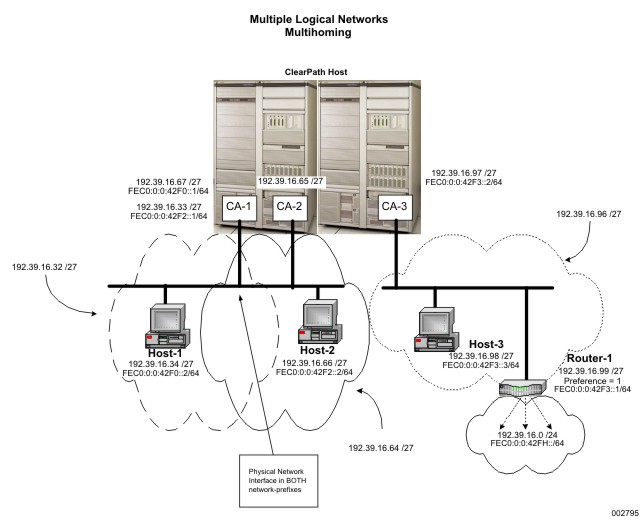In both IPv4 and IPv6 networks, a local network interface, legacy or offloaded, can be assigned up to 32 local IP addresses and can be configured to participate in more than one logical subnet or supernet, providing the underlying physical network is properly constructed.
One-to-one mapping of local IP addresses to network interfaces is no longer necessary, which allows support for many local IP addresses mapped to a single, common network interface. Multiple IP addresses per network interface allow the mapping of many host names (non-aliased), each to a single IP address also within a single server, even though that server might only have one physical network interface.
Since multiple logical interfaces (IP addresses) can be mapped to a single physical network interface, the multihoming model can be extended to include support of multiple logical networks as shown in Multiple Logical Networks Topology.
The topology shown in Multiple Logical Networks Topology is configured to have three aggregated addresses: 192.39.16.32/27, 192.39.16.64/24, and 192.39.16.96/27 (assuming an IPv4 network in this example). Both 192.39.16.32/27 and 192.39.16.64/24 share the same physical network, whereas 192.39.16.96/27 is a separate physical network.
To demonstrate multiple logical networks, the ClearPath server in Multiple Logical Networks Topology has two logical interfaces, 192.39.16.33/27 and 192.39.16.67/27. Each share a single physical interface, CA-1, and one logical interface, 192.39.16.65/27, that uses a separate physical interface, CA-2. Both physical interfaces connect to the same physical network.
Thus, this ClearPath server is connected to a single physical network, configured to handle traffic for each of two different logical networks. As configured, there are three logical interfaces (local IP addresses) servicing the same physical network. Two of these logical interfaces share a single physical interface, CA-1, while the third logical interface uses a separate physical interface, CA-2.


